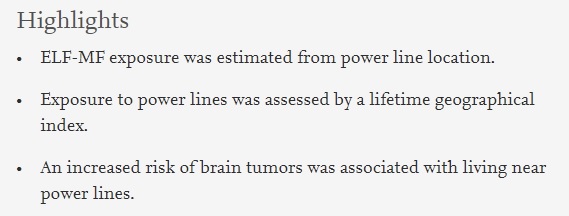Camille Carles, Yolande Esquirol, Maxime Turuban, Clément Piel, Lucile Migault, Camille Pouchieu, Ghislaine Bouvier, Pascale Fabbro-Peray, Pierre Lebailly, Isabelle Baldi,
Residential proximity to power lines and risk of brain tumor in the general population,
Environmental Research, Volume 185, 2020, 109473, ISSN 0013-9351,
https://doi.org/10.1016/j.envres.2020.109473.
(https://www.sciencedirect.com/science/article/pii/S0013935120303662)
Abstract

The effect of ELF-MF on human health is still controversial, particularly as regards long-term health effects like cancer. The literature does suggest, however, that they could be involved in the occurrence of brain tumors, although results concerning residential exposure are scarce. Our objective was to investigate the association between residential proximity to power lines and brain tumors among adults in France by using a geographical information system.CERENAT is a population-based case-control study carried out in France in 2004–2006. We used geographical data sources on power line location to create exposure scores based on distance between residence and power lines, and on the number of lines near residences. Conditional logistic regression for matched sets was used to estimate Odds Ratios (ORs) and 95% confidence intervals (95%CI).We found significant associations between cumulated duration living at <50 m to high voltage lines and: i) all brain tumors (OR 2.94; 95%CI 1.28–6.75); ii) glioma (OR 4.96; 95%CI 1.56–15.77). Further investigations are needed, particularly to improve the quality and availability of geographical and technical data on power lines.
Extract
Despite this study’s limitations, our results strongly suggest that the risk of brain tumor, and particularly gliomas could be associated with residential ELF-MF exposure estimated by proximity of power lines, as several previous studies have already pointed out. This study demonstrates how public cartographic data can be used in epidemiological studies to estimate residential exposure, even if they were not designed for this purpose. The limitations resulting from the original purpose of these data could be overcome by combination with other data sources, such as power line characteristics or metrology to enhance exposure assessment accuracy.
https://www.sciencedirect.com/science/article/pii/S0013935120303662?via%3Dihub
